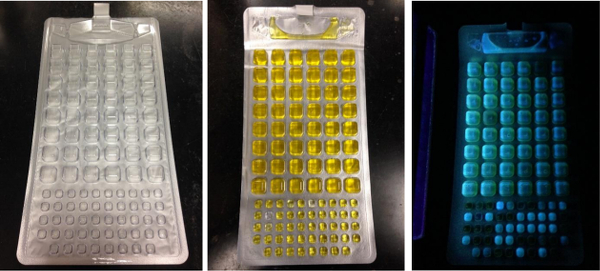Water Quality Analysis via Indicator Organisms
Source: Laboratories of Dr. Ian Pepper and Dr. Charles Gerba -The University of Arizona
Demonstrating Author: Luisa Ikner
Water quality analysis monitors anthropogenic influences such as pollutants, nutrients, pathogens, and any other constituent that can impact the water’s integrity as a resource. Fecal contamination contributes microbial pathogens that threaten plant, animal, and human health with disease or illness. Increasing water demands and strict quality standards require that water being supplied for human or environmental resources be monitored for low pathogen levels. However, monitoring each pathogen associated with fecal pollution is not feasible, as laboratory techniques involve extensive labor, time, and costs. Therefore, detection for indicator organisms provides a simple, rapid, and cost effective technique to monitor pathogens associated with unsanitary conditions.
1. Colilert Presence – Absence (P – A) Test
- Open the 100 mL plastic Colilert bottle. The bottle includes a small amount of powdered reagent that is necessary for the proper reactions, do not discard this powder.
- Add 100 mL water sample into Colilert bottle.
- Open the pillow tube containing the nutrient substrate and pour the contents into the water sample inside the Colilert bottle.
- Cap and seal the Colilert bottle. Shake the bottle vigorously, repeatedly inverting the
Indicator organisms are employed to rapidly and inexpensively determine environmental contamination. Colilert assays are utilized to analyze water quality for drinking, recreational, and wastewater sources. Water quality must meet legal standards set by the Environmental Protection Agency (EPA) and state regulatory departments in order to be accepted as a resource for human and/or environmental consumption.
Colilert assays are also strategically used as mass balance markers within environmenta
Skip to...
Videos from this collection:

Now Playing
Water Quality Analysis via Indicator Organisms
Environmental Microbiology
29.2K Views

Determination of Moisture Content in Soil
Environmental Microbiology
357.0K Views

Aseptic Technique in Environmental Science
Environmental Microbiology
125.0K Views

Gram Staining of Bacteria from Environmental Sources
Environmental Microbiology
97.4K Views

Visualizing Soil Microorganisms via the Contact Slide Assay and Microscopy
Environmental Microbiology
41.7K Views

Filamentous Fungi
Environmental Microbiology
55.0K Views

Community DNA Extraction from Bacterial Colonies
Environmental Microbiology
28.6K Views

Detecting Environmental Microorganisms with the Polymerase Chain Reaction and Gel Electrophoresis
Environmental Microbiology
44.0K Views

RNA Analysis of Environmental Samples Using RT-PCR
Environmental Microbiology
40.1K Views

Quantifying Environmental Microorganisms and Viruses Using qPCR
Environmental Microbiology
47.5K Views

Isolation of Fecal Bacteria from Water Samples by Filtration
Environmental Microbiology
38.4K Views

Detection of Bacteriophages in Environmental Samples
Environmental Microbiology
40.4K Views

Culturing and Enumerating Bacteria from Soil Samples
Environmental Microbiology
182.1K Views

Bacterial Growth Curve Analysis and its Environmental Applications
Environmental Microbiology
294.3K Views

Algae Enumeration via Culturable Methodology
Environmental Microbiology
13.6K Views
Copyright © 2025 MyJoVE Corporation. All rights reserved

